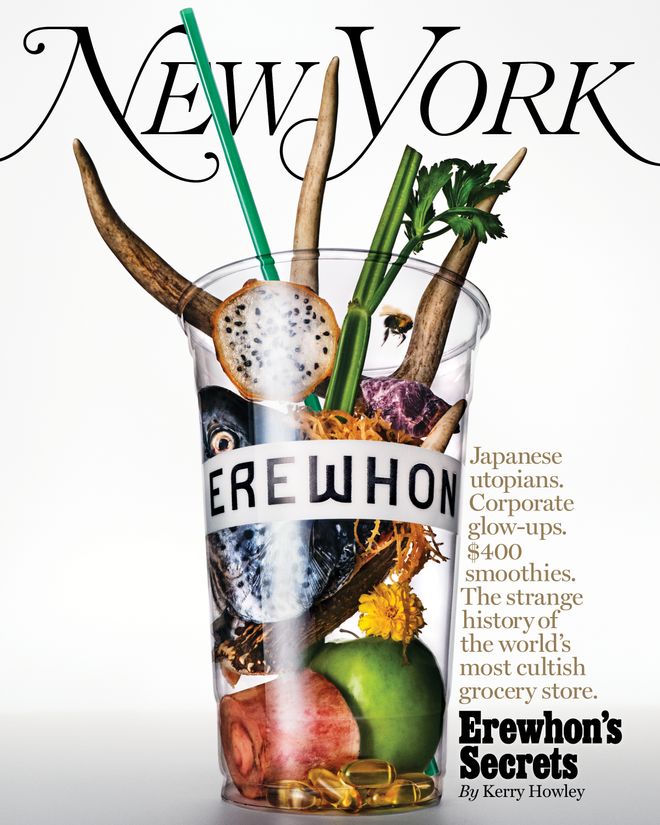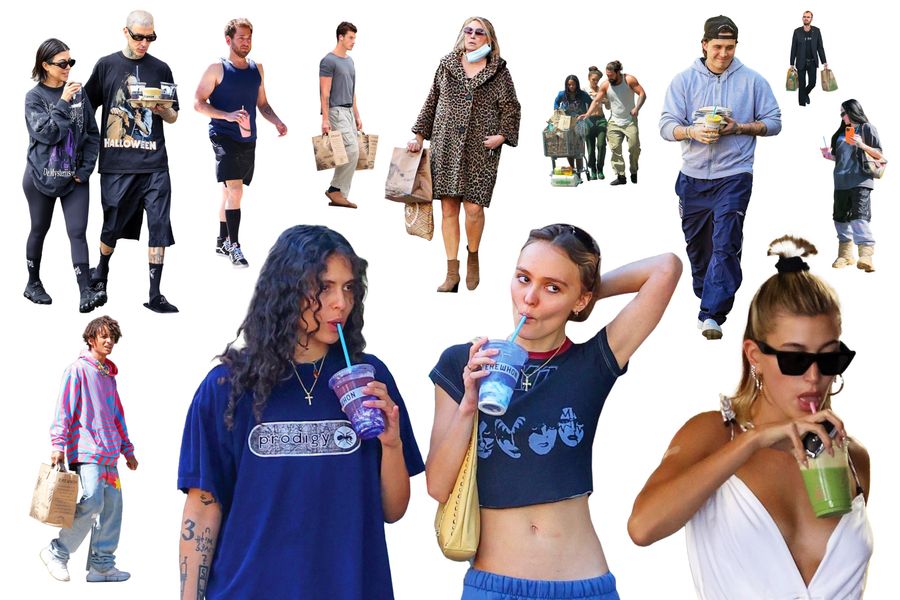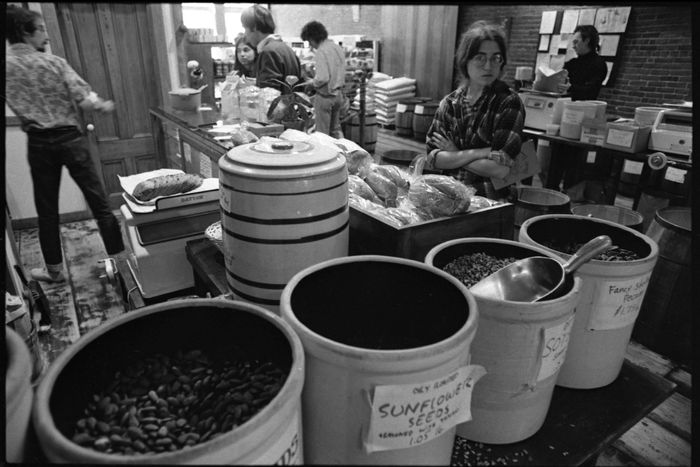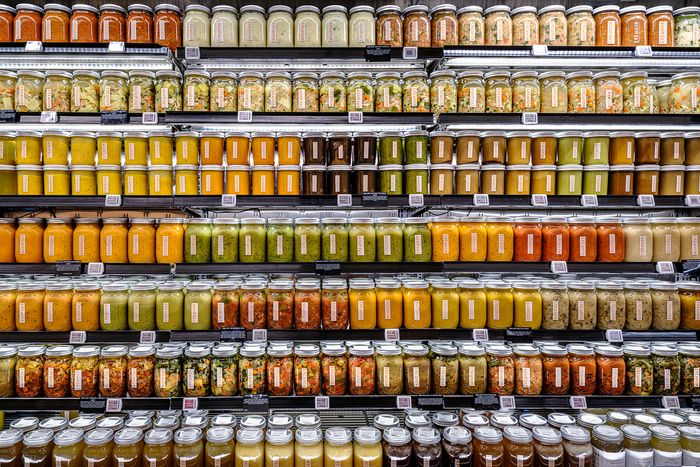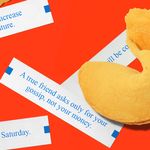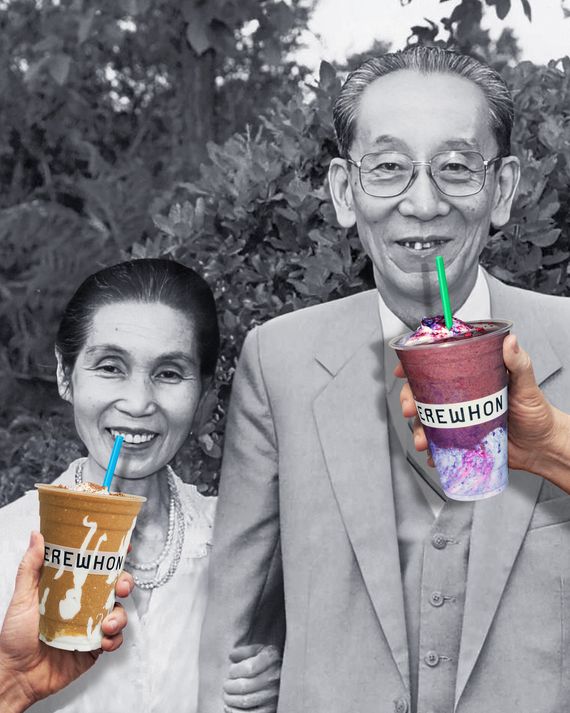
This article was featured in One Great Story, New York’s reading recommendation newsletter. Sign up here to get it nightly.
It’s 9:30 a.m. on a Wednesday in Pasadena, and it ought to be a sleepy morning on South Lake, there beside the Macy’s and T.J.Maxx and Ross Dress for Less and various other retail establishments one might reasonably have thought had gone bankrupt, but more than 300 people have swarmed the sidewalk and many have been milling for hours. They were drawn here by the promise of what passes, at Erewhon, for a deal: the secular privilege of spending $200 on groceries to receive, in turn, a tote bag full of on-brand Erewhon goods (dragon-fruit–rose pick-me-up beauty water, two kinds of avocado oil, beekeeper’s immune spray), alongside the immeasurable spiritual privilege of being among the first inside the tenth location of America’s buzziest grocery store.
There’s a ribbon to be cut, though the threshold has already been crossed; last night, Erewhon summoned 400 influencers through sliding glass doors. Those influencers have already posted their “Get ready with me” TikToks (“I feel so grateful and blessed to have been invited to this”), attended the launch, gone home, set up their cameras across from their full goody bags, and posted their hauls (“Our new Erewhon hats? How cute? Literally so cute. We love.”). At the grand opening, which follows the influencer event and precedes a “wellness event,” there are, at any given time, several people walking the sidewalk and filming said line with their phones. There is a man holding up his phone and spinning for an aerial view of other people waiting. The very first shopper, Kathleen O’Heron, snagged her place at 5:30 and will have waited four and a half hours to get in. “Why?” I ask her. “Great question,” she says. “Content.”
The goals of posting and healing work in tandem. O’Heron had been diagnosed with a cardiospasm, and trips to Erewhon had helped her through; another woman on line, a mother, tells me clean eating cured her son’s eczema. Inside, there will be 20,000 square feet of beautifully lit product, an open kitchen buzzing with black-uniformed cooks, and more lines: The tonic-bar line runs 20 minutes, then 20 minutes more to get your smoothie. “The line outside is fucking retarded,” I hear a man say, but in order to be in the store at all, he must have made the effort to arrive hours early. His sentiment is not widely shared. For the most part, today and all days, the lines at Erewhon partake of an astonishing calm, as if everyone is a touch high. A 50-something woman in giant Celine sunglasses carrying a quilted bag that says GIVE A DAMN holds out a $52 candle to a much taller woman, a stranger, also in line, to catch the scent of citrus and vetiver. “I love this,” she says amiably. You’re in line, and you’re lucky to be there. You’re in line, but there’s no rush. You cannot really expect your $18 Hailey Bieber’s Strawberry Glaze Skin smoothie to come quickly, and no one does.
Cover Story
“When you think So L.A., Erewhon smoothies, Barbie-pink sunsets, and baristas with IMDb credits might come to mind,” reports the Los Angeles Times, casually privileging in the pantheon of California icons a grocery store’s juice bar over Hollywood and the sun. This store will do, this week, $1 million in sales. A woman tells me she moved from Harlem to L.A. “for Erewhon”; a professor friend calls it “a central part of my L.A. existence.” Whole Foods “is copying us now,” an employee says. Something has been worked out here, some mystery solved, in the 57 years since Erewhon came into being. Someone has seen past what we say we want to whatever it is we will actually buy, a process of discovery that began with Japanese utopians and progressed to $40 jars of sea-moss gel “sourced from the pristine waters of St. Lucia,” sincerely said to strengthen bones and blood.
You are meant to believe genuinely in the sea gel’s powers. Erewhon is a deadly earnest place. And yet. “The one thing I’ve done today,” said StraightioLab podcast host George Civeris upon landing in L.A., “is gone to Erewhon as a bit to get a $13 smoothie.” Erewhon does not participate in, but will knowingly profit from, the bit. The bit involves a TikTok genre premised entirely on the store’s excesses. (“What’s your net worth? $500K? Whole Foods is that way.”) “We see them filming,” says CEO Tony Antoci, unbothered. Your L.A. friends will roll their eyes, but they also have $200-a-year Erewhon memberships. Your New York friends will come as a joke, but they will come before they hit LACMA, and their money is just as real.
The day in which New Yorkers can partake of Buffalo cauliflower ($19 a pound) on their own turf is always just upon us, a rumored pop-up away. “We are gonna be in New York,” vice-president Jason Widener tells me. “We are gonna be in New York.” Erewhon is one of those phenomena that is ever present if you’re tuned in and invisible if you are not. “Isn’t that just a grocery store?” asked a friend who has lived in L.A. all her life. No, it is not, and has never been, just a grocery store. It exists within, and has always occupied, a space between commerce and cult.
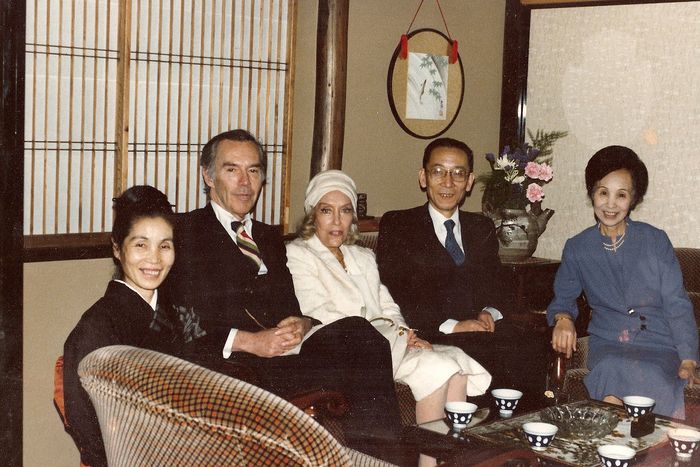
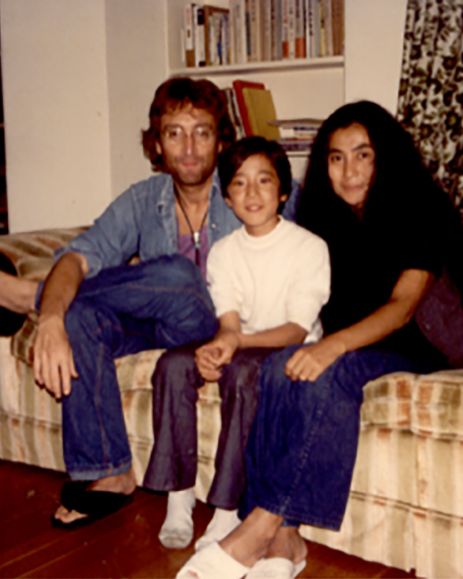
In 1951, a Japanese woman named Aveline Yokoyama disembarked in San Francisco with the intention of meeting someone in New York. She spoke no English, had no money, had never been out of Japan before. She was 28 years old and alone in a country that had recently incarcerated 125,000 people of Japanese ancestry. There was, Aveline would later say, “almost no good food” in America. She was less than five feet tall, and everyone I spoke to for this story sounded slightly afraid of her.
Aveline had come to meet a bookish, abstract man named Michio Kushi, having read his letters from afar. She had a Greyhound bus ticket to get to him. In Denver, she tried to buy bread but, having tasted it and detected sugar, left the whole loaf on a bench. On the bus at night, she watched a deer cross the road against the beam of headlights. She got off the bus in what she thought was Chicago, but it was Omaha. Someone took her to an Asian restaurant. A Chinese woman put her on the next bus east.
Aveline was not her name in childhood; it had been given to her rather recently by a charismatic man named George Ohsawa, a 50-something sage who told Japan’s bomb-traumatized youth he knew a better way. Michio had studied with him too. Ohsawa gave Aveline permission to leave the sect, go abroad, and act as an ambassador for what he called the Unique Principle. He believed the only way to ensure world peace was, essentially, to eat more whole grains. Sugar was poison. Vegetables were good, though never eggplant or potatoes. Meat? Out of the question. One had to balance yin foods with yang ones, a conceptual framework that came not from Japan but China; each food was one or the other, a compendium of knowledge one could spend forever studying. His mother and two younger brothers had died of tuberculosis when he was just a child, and Ohsawa was determined to live. He could diagnose you by looking at your eyes: If they had white around three sides, you were sanpaku, which, among many other things, suggested the risk of dying a violent death. He called his diet macrobiotic. “Is it all right to drink milk?” was the last thing Aveline said to him as she left Japan. “No,” he said.
In New York, Aveline found Michio. He was tall and skinny and, she thought as he struggled with her bags, not very strong. He talked always of “the fate of the world,” and he was “invariably preoccupied with some peace or world-government project.” If she picked wildflowers, he was saddened. She ate Quaker Oats, Norwegian flatbread, and Nabisco biscuits. A Buddhist priest told her to go home and start a family, be normal. But normal was not the direction in which she was trending. Within two years, she was pregnant with her daughter, Lily. She didn’t marry Michio until she was pregnant again, with a son, Norio. The marriage was at City Hall in the mid-’50s, and later, neither she nor Michio could remember the date. She considered it to have been arranged by Ohsawa.
Michio and Aveline continued to have children and moved from ordinary jobs in New York to what they called “macrobiotic education” in Cambridge, Massachusetts. They dressed carefully — Michio was invariably in a three-piece suit, Aveline often in a kimono. They watched clean young men walk in and out of Harvard Yard and thought such boys would be good students for their philosophy. But primly dressed Harvard boys were not the people interested in Michio and Aveline.
“I guess you would call them raves now?” says Bill Tara. It was 1960-something, and he was throwing psychedelic light shows in a firehouse in San Francisco. He was a 24-year-old with a small theater company squatting in an abandoned hotel. He came across a book called Zen Macrobiotics, by Ohsawa. It seemed interesting to Tara to eat nothing but brown rice and tea for ten days, and after he did so, he felt transformed. He had had an ulcer, and now it was gone. Another man living rent free in the hotel, Paul Hawken, tried the fast. He had been asthmatic since infancy. “On the eighth day,” he later wrote, “I woke up with an unknown sensation. I felt air deep down in my lungs for the first time.”
Tara knew nothing of the other food in the book. Even rice was pretty unusual, the kind of thing you encountered at a Chinese restaurant or poured from a can of Chef Boyardee. Food was fuel; you might get out of having to eat anything at all if you could find the right vitamins. It was an age of white bread, Twinkies, 400 food additives recently invented and deployed. There were not “natural food” stores. There were “health food” stores that sold supplements in glass bottles and were staffed by women wearing nursing uniforms to give an aura of medical legitimacy. No one was selling tofu. Tara and his friends got tips on the street in San Francisco. He wanted millet, but the only place to get millet was at the pet store; it was meant for parakeets. When a man at the pet store brought out the tiny packets, Tara sent him back, incredulous, for a whole pound. “We heard that somebody had miso,” Tara said. “We went up and knocked on the door. And I said, ‘I hear you have some miso.’ And he said, ‘Yeah.’ We went inside and he had this big keg of miso underneath his bed in his apartment.”
Eventually, Tara and Hawken made their way separately from San Francisco to the center of macrobiotic life in Massachusetts, where Michio’s admirers lived in a series of “study houses.” Michio lectured, Aveline cooked. They had restaurants, an institute, a magazine. In their home, their children bagged grains to distribute to the students. Michio and Aveline wanted a place where they could sell the kinds of foods integral to their diet, so they opened a tiny store below street level, almost a stall, with bins full of loose grain and seeds on Newbury Street in Boston. It was 1966. You could buy ten pounds of bulk food for a couple of dollars. They would call it Erewhon, an anagram of Nowhere, after Samuel Butler’s satirical novel of the same name, one of Ohsawa’s favorite books.
When Hawken started working at Erewhon, the store was doing $25 a day in sales. He thought he would get a lot of reading done. “I had no intention at all of going into the food business,” he says. “I was, like, happy not having business.” But Hawken, whom one ex-colleague calls “very dynamic, very brilliant, and very aggressive,” started to get questions about the foods he was selling. “How do you know these oats are organic?” someone asked. Because it said ORGANIC on the label. Because they bought them from Mennonites and “Mennonites don’t lie.” Bothered enough to look into it, Hawken did some research, made some calls. Sometimes, it turned out, Mennonites do lie. “That pissed me off,” he says. “How do you know the oil is cold-pressed?” a customer asked. It said so on the bottle. A single letter revealed that the oil had been cold processed — totally different. Soon, Hawken was on the road, alone in his pickup, sourcing organic and natural foods for Erewhon. In Montana, he learned to tell good wheat from bad by chewing raw kernels in his mouth, feeling for the right amount of gluten. In Louisiana, he drove past dead pelicans poisoned by mercury fertilizer. He convinced people to sell him unprocessed cooking oil (“You want this before I refine it?” an Oklahoma man asked), and he smelled, for the first time, the scent of pure sesame oil. “You don’t think of oil as having a scent,” he tells me. “But the scent — oh my God — it smelled so good, so flowery and beautiful.”
Every Erewhon is different, but they are all deeply comforting, sanitized simulacra of their respective neighborhoods. Patrons of the Beverly Hills Erewhon carry, one finds, more hardware: heavy jewelry, small dogs. The boots are bigger, the men’s purses more insistently structured. You are likely to see at least one woman in futuristic wraparound sunglasses and black activewear, looking as if she had just landed, holding a clear box of Buffalo cauliflower. In the Silver Lake Erewhon, my Erewhon, the Erewhon I walk to when I need to be around people and also judge them, one is likely to see more tattoos, more alt-comedians slouching against the glass as they sip their Jing City tonic (deer antler, goji shisandra, ground-up black ants), but even here there is the ever-present wet gloss of an influencer who has molded herself to the platform: dewy face, slick hair, gently parted lips. There are usually one or two people in pajamas, a kind of countersignaling I associate, absent any evidence, with enormous wealth. (Here it must be said that Kanye West’s “Erewhon drip” involves wearing only one slide to the store.) Recently, I stood in line behind two women, both gingerly touching the facial-compression garments holding in their cheeks. As we waited, a tonic-bar employee opened up a bag and a powdery cloud of white collagen floated before our eyes. Nowhere, this place is called, and yet no establishment has ever seemed so perfectly evocative of its city.
This paradisiacal enterprise is the work of Antoci, not a hippie or a guru peddling “ancient Japanese wisdom,” just a business guy who had already made a fortune in food distribution. He bought Erewhon’s one remaining store in 2011 when it was a niche outpost for health fanatics. At the time, there was a shaggy guy named Truth making specialty drinks for celebrities on hyperspecialized diets. Antoci wanted to change the “grungy soap” smell and also the name. I don’t understand what it means, he thought. And it … sounds weird.
The name remained unchanged after Antoci encountered enough customers deeply loyal to it. The smell he did something about. His insight was this: People may want “natural food,” but nature itself is the inconsistent chaos from which they and their food have been delivered. They do not want nature but its opposite: civilization, control, an experience designed down to the inch. They want custom millwork and imported glazed tile. They want color breaks in the vegetables; not lettuce, then spinach, but lettuce, then radish, then spinach, such that the radishes pop hard from the sea of green. They want a kind of closed-in order — tight aisles, no gaps, warm light, relentless symmetry. “The body senses mistakes,” says Yuval Chiprut, who designed the interiors of seven of the stores. “The body senses something not right with the space.” Chiprut designed Pasadena such that a straight line from an olive tree outside leads through the store, across the seams of tiles placed to defer to the line, through the center of a sprinkler, through a 20-foot-long box emanating a color meant to mimic natural light that will change with the seasons, to the far wall, and, thereupon, the center of the W in EREWHON. “You walk in,” he says, “and you are the center of the story.”
You are at the center, and you are not alone. “When you get home after a day in New York,” says Chiprut, “you get home and you’re, like, you’re tired. You’ve interacted with people, you rub shoulders, people have violated your personal space. You’ve had to smell people. In L.A., I could get into my car in my little bubble. I could drive to work. And I could literally not touch somebody for five weeks if I didn’t want to. Grocery stores are obsessed with openness, and I find it to be such a waste of space.” At Erewhon, small spaces are redefined as “curating an experience of connective energy.” The aisles are narrow and very tall, like the stacks in a university library. There’s a quiet in the corridor, a sense of privacy there among the $18 jarred macaroons. You could easily have a private meeting in the sanctuary of an aisle; Erewhon vice-president Widener says he often does. That one cannot possibly reach much of the inventory is part of the design. You have to ask for help, and there are inevitably three people in the vicinity happy to provide it. It is this, as much as anything, that feels luxurious in our time — a store in which there is a staff.
There were other eras. There was the ketogenic era, there was the raw-food era. This is the era of verbs: Everything in the store is functioning, activating, building, oxygenating, restoring the microbiome to its halcyon bacterial state. “Hailey came to us,” says Widener. “She was at the bar. She said, ‘Why aren’t we doing a smoothie together?’” In the pre-pandemic keto era, “smoothies fell off the face of the planet,” and during the pandemic, no one wanted to wait 20 minutes in a store. But post-pandemic, the drinks, layered in colors that pop through the plastic, were TikTok-able display pieces, and Erewhon is, in the end, here to please a crowd. The market for a subtly flavored tonic featuring ground-up ants is limited. The prepared food is designed to appeal to a normal person, or at least a normal influencer, which is to say the smoothies are as oversweetened and the kale salads as overdressed as their counterparts at a food court in Kansas City. This follows a pattern seen in natural-food stores more broadly. When John Mackey started Whole Foods in 1980, 20 percent of the store was bulk foods, and when he left, less than one percent was. “People stopped cooking,” he told me. What replaced bins of grain was something barely available in 1980: processed, shelf-stable foods that met the standards of the natural-food community and now compose the center of the average Whole Foods. Bill Tara realized this while still working at Erewhon, having made some organic corn chips that sold out the first day they were available. Oh, he said to himself, the future of natural food is snacking. That’s what’s gonna happen to the whole movement. We’re gonna go back to snack foods because there’s much more enthusiasm than there was for organic brown rice.
If this is clean eating for children, then Erewhon reproduces, in parallel, a childlike sense of novelty. One does not come with a list; one roams hoping to be alarmed ($20 dry shampoo for dogs) and intrigued ($26 “oxygenated” water). At the wellness event, I watch a nun in a full habit accept a small cup of sunflower milk. “Have you tried sunflower milk before?” asks the sunflower-milk man. “No you haven’t,” he says. “No one has tried this before; that’s a trick question.” There are no informative signs, no markers hung from the ceiling drawing you in the direction of “activated walnuts” or a $138 canvas tote bag. You are at the center of your healing journey, and you must, yourself, happen upon the protein-packed cassava Cult Crackers.
Aveline was raising five children in this country with “no good food.” They foraged for dandelion greens in the park. They harvested seaweed off rocks on the North Shore outside of Boston. Phiya Kushi recalls being in primary school in the late 1960s and looking with some disgust at the meals of his white peers: peanut butter and jelly on Wonder bread, cow’s milk. He preferred the nori rice balls his mother made, but the teachers were “concerned.” They forced him to buy a school lunch of meat loaf. He wept. His mother came in, sized everyone up, and found the relevant loophole. She insisted on a “religious exemption” such that her son could eat a macrobiotic lunch. She drove home with a license she had obtained by bribing the man who had administered the test.
Ohsawa’s fame was growing, which drew ever more people to the Kushis. He and an American acolyte had written a book called You Are All Sanpaku, dedicated to 36 celebrities whose eyes Ohsawa found to be excessively white-rimmed, including Natalie Wood, Roy Cohn, Günter Grass. It was a warning to them; if they didn’t eat better, they might come to a bad end. JFK had been sanpaku, and just look at what happened to him. The book advises increasing salt, severely restricting liquids (women should urinate twice a day, max), and chewing every mouthful 50 times. A 24-year-old woman on the Lower East Side, Beth Ann Simon, thought perhaps she was too sanpaku. Possibly anorexic, she put herself on an extremely strict macrobiotic diet, wrote to Ohsawa, and ignored the advice of her alarmed family as she dropped more and more weight and developed sores suggesting scurvy. On the last day of her life, her husband was with her, trying to revive her with carrot juice. “Then her head rolled back in his hands,” wrote Robert Christgau in a now-classic New York Herald Tribune story on the subject, “her eyes became very sanpaku, and she died.”
The FDA shut down the Ohsawa Foundation in New York and raided Erewhon’s belowground Boston store. One could sell food, but one could not legally sell both the food and books making health claims about the diet. The store was selling copies of Zen Macrobiotics out of its back room. As the agents went to their car to get a flashlight, Aveline dumped all the books in a trash can and covered them with newspapers. When they returned, she sat on the trash can for the remainder of the raid. Erewhon remained open.
Aveline and Michio moved their family to Wellesley, where they lectured and cooked and violated very many zoning laws. They were, in their youngest son Hisao’s telling, “kicked out” of town. (“It would be best for all of us if you went away,” a member of the board of selectmen told Michio.) They eventually resettled in Brookline, where their home was eternally full of young people studying the Kushi way. Hisao noticed that American hippies would arrive from the West Coast, come to live in the vicinity of his Japanese father, and begin speaking, like his father, broken English. Their father referred to pizza as pizza pie; the hippies started saying pizza pie. If a friend called the house and asked for Hisao, there would be confusion, but if they said “Michio’s son,” someone would find one of the boys. Michio could not drive. The one time he tried, he directed the car into a bush. But he could lecture all day long. “He would start out a lecture by talking about the position of galaxies,” Tara recalls, “and he ended up talking about the reason you had the number of teeth that you do.” He offered “consultations” for a price. He could tell you just what foods you needed to restore your yin and yang to balance. The diet was broadly prescient, and much of it would later be validated by science: fermented foods, low sugar, brown rice, vegetables. But as Michio was giving consultations, there in his rumpled three-piece suit, he was invariably smoking. Smoking, he said, was okay, so long as you kept the rest of your diet in balance.
Aveline and Michio were not businesspeople; they were ideologues. They taught that their diet could cure basically any malady, cancer in particular. They started Erewhon in the bunkerlike underground space in Boston and mostly left it to a bunch of young men, none of whom had business experience beyond the psychedelic-light-show industry. A man could show up for the first time on a motorcycle and be running Erewhon shortly after. One of the key employees, Jimmy Silver, had recently been the original manager of the Stooges; Roger Hillyard, a former general manager, had been living off the grid in New Mexico. The store took off. There was simply nowhere else on the East Coast to buy natural food with knowledge of its origins. They moved the store to a much nicer aboveground location in Boston. The men worked 12-hour days sourcing food, securing warehouse space, putting out fires. They cut their hair because Aveline told them to. They did not take salaries. If they needed shoes, explained Tara, “we’d just go to Aveline and say, ‘I need some shoes.’ She’d say, ‘Okay, well, there’s a big sale happening at this department store. Here’s some money. Go and buy some shoes.’”
When Hisao was 3 years old, he slipped on a roll of Scotch tape and badly hurt his knee. Doctors suggested he would need surgery, but Aveline and Michio were averse to western medicine. Aveline took Hisao to Los Angeles, where he could undergo Japanese bone-massage therapy. She set up a study house in Hollywood and established a small “Erewhon West” on Beverly Boulevard, Erewhon’s first foray into the Los Angeles market. She hosted movie stars, invited ever more students into her home, and was ticketed for driving too slowly on the highway.
By 1978, Erewhon was doing $10 million in annual sales. As the company grew, there were questions about how closely a business interest should hew to the strictures of Ohsawa’s diet. Should it sell bananas? Yogurt? “Potatoes were never sold on my watch,” says Tara now. “And forget about tomatoes, man. I can remember a cashew rebellion.” But there was something deeper, beyond the choice to sell banned nightshades, something unsustainable in the structure of a place held together by 20-something true believers. As Erewhon grew, it required more and more people to run, and not all of those people had made their way through Ohsawa’s 300 books or tried to eat exclusively brown rice for a week. An unhappy worker might be told he was “unbalanced” and instructed to attend a lecture, change his diet.
Some of the workers were so unbalanced, they unionized. “We were deeply shocked,” writes Aveline in her memoir. “The essence of our teachings is gratitude of nature and respect for other people … the union was concerned with taking, not giving.” Erewhon continued to grow, and it financed that growth with loans it became unable to pay. The store had always been casually run. “One day it came to me,” Hillyard said. “Wait a minute, it seems to me businesses have something called books. Oh my God. And we don’t have any.” By 1981, just before the Kushis began claiming the macrobiotic diet was a cure for AIDS, Erewhon was bankrupt owing to its own mismanagement. There were other health-food stores now, stores that sold yogurt without provoking existential crises among their founders, and now there was something new to the world: natural-food supermarkets. Whole Foods was the first in 1980 and would acquire very many smaller health-food stores, though never Erewhon.
Before the bankruptcy, the L.A. store had already been sold to one of its employees, Tom DeSilva, and it was under his ownership, in the mid-aughts, that Erewhon reached its highest and weirdest potential. At that Erewhon, run by DeSilva’s wife, you couldn’t buy red meat (poison) or alcohol (poison), but you could buy American Spirit cigarettes (organic). In 2007, years before Antoci had given Erewhon its slick corporate sheen, Truth Calkins was running what might have looked like a place to get a juice. “It was the greatest job I ever had,” Truth told me via his laptop, on an app he asked me to download to avoid the EMF from a smartphone. Before he worked at Erewhon, he had been ill: Epstein-Barr, chronic-fatigue syndrome, a reliance on antibiotics that left him frail and vulnerable. He quit his graphic-design job, holed up in a basement in L.A.’s Bronson Canyon for three years, read every book he could find on alternative medicine, made himself well, and, later, made his way to the tonic bar. Normal people, says Truth, were afraid of him, the intense blond guy in the handmade Nepali shirts tearing open packets of powder and running three blenders at once. But L.A.’s health conscious came to Erewhon only for the magician who knew Chinese herbal medicine, raw food, ketogenic diets, supplements, macrobiotics. It was, he says, “a healing center disguised as a juice bar.” He was a “speed healer.” A customer would come in and he’d channel “a divine portal for higher energy to come down,” which is to say he would become “very calm” and stand as close to the customer as possible, “stare deep into their being,” and ask, in a quiet voice, about the problem. “I would focus on them so deeply,” Truth says, “that it was like confession at church.” You could confess your acne, your low libido, your common cold. Headache? Here’s three glasses of hexagonal-structured water, a lypo-spheric vitamin-C packet, and an “elixir,” “mushrooms in a warm gynostemma tea with adaptogens like reishi.” He’d pick a song and play it for you. He’d spritz you with a flower-essence pomander spray to “clear negative energy off your aura.” Thirty minutes later, you’d be sitting in the chair, “stress lines going away from your face, blood-flow circulation coming back, waves of serotonin coming up. You look years younger, high, you’re in the moment.” He’d “plug your kidneys into the cosmos.” He’d “fly all night long and just sling Jing.” There would be development execs reading Variety, drinking one of his elixirs and eating seaweed salad topped with sardines. There would be people sitting and meditating, lost on the mushrooms Truth had given them. There would be people who came for the scene, people who came to see people after a day alone in L.A. Amanda Chantal Bacon, the founder of Moon Juice, was a regular. Forest Whitaker came in, as did, according to Truth, “scouts from Whole Foods, just like the Gestapo, two guys in suits.” His customers wanted an indulgence, a treat, but not at the cost of contamination. Truth charged $25, $80, $400 for his drinks and various creations, incredible amounts in 2007, but the tonic bar still lost money. He was roaming the aisles, speed-healing with expensively sourced supplements and powders and herbs, lavishing 30 minutes on a single person’s problem.
People thought he owned the place; he was an employee making $21 an hour. Spiritually, though, Truth did own the place. And so when Antoci the business guy showed up, having bought Erewhon from DeSilva’s wife, Truth thought, Who the fuck is Tony? And when Tony started making changes, Truth walked.
Erewhon’s Wikipedia page describes the titular Erewhon of the 1872 novel as a “utopia in which individuals are responsible for their own health,” but this is not what even a casual reader would take from the text. Erewhon is a work of satire, the literary side-eye of a man who ran as far as possible from his stern Anglican preacher of a father to write, in far-off New Zealand, brilliantly deranged works of fiction. The world that Butler’s hapless, misguided narrator comes upon, the world of Erewhon, is an ironic reflection of the England Butler abandoned. The most notable aspect of Erewhon is this: People are prosecuted not for ethical breaches but for the crime of being ill. Citizens hide their illnesses at all costs. Doctors are illegal. “This is not your first offense,” the judge says to someone being sentenced to life in prison for the crime of pulmonary consumption. “You were convicted of aggravated bronchitis last year.” The narrator flees when he learns he will be framed for the crime of contracting measles. This is not utopia but its opposite. Describing Erewhon as a “utopia in which individuals are responsible for their own health” is like describing Orwell’s Oceania as a “utopia in which individuals are responsible for their own information security.” And so this is the question I confront in Silver Lake: Could it be that America’s buzziest grocery store, its wellness mecca, was named in honor of the idea of incarcerating sick people? And no one noticed?
Perhaps Ohsawa had focused on another aspect of the novel’s text. Perhaps, I thought once, something had been lost in translation. This does not seem to be the case. “Quoting Samuel Butler’s Erewhon,” Aveline writes in her memoir, Ohsawa “would say that sick people should be sent to jail and criminals should be sent to the hospital.” She and the others “admired this imaginary realm.” Antoci told me he hadn’t read the book: “I’m not that kind of guy.” Chiprut the designer hadn’t read it “in its entirety.” Truth had not read it. “That’s a wild book,” said Widener, who certainly had read it, and moved quickly on from the subject.
Totalitarian societies operate by rendering almost everything illegal and cracking down whenever it suits. An extreme diet operates with the same prosecutorial subjectivity; when illness manifests, no one is free from blame. Ohsawa died at the age of 72 in 1966. In her memoir, Aveline attributes the death to his attempts to experiment with a macrobiotic soft drink. The drinks “may have been too yin” for his heart, ultimately killing him. Lily Kushi, the couple’s first child, died at 41 of cervical cancer. “She avoided eating many foods that weren’t good for her, but not completely,” Michio wrote in his ninth book, The Cancer Prevention Diet. “She especially liked salmon … She never ate meat, very rarely eggs, and ate a little sugar on social occasions. She developed cervical cancer from indulging primarily in this extreme diet. Salmon is a red-meat fish and extremely yangizing. Her cancer appeared in the cervix, a very yang, constricted organ.” Aveline died, also of cervical cancer, at the age of 78. “She loved fried kombu, the strongest sea vegetable,” wrote Michio, “and she enjoyed deep-fried sourdough bread. Baking and deep-frying are each very yang and in combination are extremely tight-ening. The end result over time was cervical cancer, a very yang tumor.” “I think because my father in particular really emphasized this macro and cancer-prevention diet book and everything,” his second-oldest son, Lawrence, told me, “there was this sort of shame or guilt attached to people developing cancer.”
The macrobiotic community incubated stores and brands that mainstreamed a far healthier way to eat — Boston’s Bread and Circus, Michigan’s Eden Foods, among many others — and there is little doubt many have lived longer and better due to its advice. The community also had a problem with quackery, and the diet, as practiced by some of the strictest adherents, was restrictive in a way few doctors would recommend. The most intense adherents to the diet, according to two former members of the community, might have been malnourished, and bingeing in secret was common practice. A former member says alcoholism was rampant; another former adherent says he drank alcoholically while on it. One of the diet’s most famed proponents claimed it had cured him of prostate cancer, but when the cancer came back and killed him, no one wanted to talk about it.
We are vulnerable, every one of us, in our desire to be well. There is no approach to wellness that does not involve some amount of accountability, which turns easily to blame for dysfunction beyond our control: life in prison for a case of measles. It is worth asking, then, what wellness looks like in its most anodyne, least manipulative form and whether that looks like a nun sipping sunflower milk under a cloud of collagen peptides. Hailey Bieber’s Strawberry Glaze Skin smoothie, a product of naked market forces, will not blame you for your incurable chronic disease or even claim to treat it. Hailey Bieber’s Strawberry Glaze Skin smoothie may be, as Truth says, “one step up from Jamba Juice,” but it contains within itself Truth’s spirit, the dream of the salutary indulgence made available to the common man, or what passes for one in Calabasas.
Not everything capitalism destroys deserved to endure. Ohsawa’s wild, purifying impulse lands softly here, in an $8 handful of popped water-lily seeds from a bag easily torn open and resealed. You needn’t move in with a family of seven, stop drinking liquids, or declare yourself sanpaku. That the extant Erewhon invites our mockery is in fact part of its strength: Irony is our best bulwark against fanaticism. “Oh, you don’t buy your eggs in a circle?” asks @VincentMarcus on TikTok, holding six Erewhon eggs in a round package. “Go back to Whole Foods!” You can both laugh at the eggs in the circle and want the eggs in the circle, but you cannot both laugh at the circle eggs and lose your identity to them.
Aveline never did drink cow’s milk; the ambassador for the Unique Principle did as Ohsawa asked, and in doing so she changed the country to which she had come. Lawrence enrolled in public-health classes at Harvard while living at home, shuttling between two communities, each of which thought he was being brainwashed by the other. He is now a director of policy at Kaiser Permanente, where he researches the role of nutrition in the development of cancer. Hisao, the little boy who slipped, the 3-year-old responsible for Erewhon’s genesis on the West Coast, is now 58. His knee healed, one way or another, and Aveline took him back to the East Coast. As an adult, he moved back west to Santa Monica, thinking he would write movies. That didn’t work out. Eventually, Hisao Kushi, the youngest son of the woman who had gotten off the bus in Omaha thinking it was Chicago, became co-founder of a health-focused business, something that would inspire, as his parents had, intense devotion. The company was called Peloton.
Photo (celebrity clients): WCP,4cnrs / BACKGRID (Kourtney Kardashian, Travis Barker); Splash News/Shutterstock 2023 (Shawn Mendes); SPOT/BACKGRID (Brooklyn Beckham); CPR/BACKGRID (Jonah Hill); Bruce/Javiles/BACKGRID (Lily-Rose Depp and her 070 Shake); Bauer-Griffin/GC Images (Ringo Starr); Splash News/Shutterstock (Jaden Smith); RAVL, SOLO/BACKGRID (Noah Cyrus); Jishphoto/Shutterstock/SplashNews (Jason Momoa, Lola Momoa); Clint Brewer/BACKGRID (Hailey Bieber); Splash News/Shutterstock (Jennifer Coolidge).



